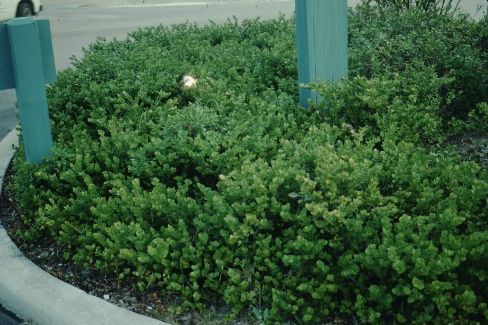Introduction
Dwarf natal plum is an evergreen ground cover that is known for its attractive foliage, flowers, and fruits. This dense, spreading plant will reach a height of only 12 to 18 inches. The natal plum has small, leathery, ovoid leaves that are dark green in color accompanied by sharp, bifurcate (forked) spines about 1 ½ inches long. White, star-shaped flowers that are 2 inches wide appear throughout the plant in the spring. The fragrant flowers are solitary and have overlapping petals. Bright red fruits are about 2 inches long and ripen throughout the year. They are plum-shaped berries occasionally used for jellies and preserves. Twigs bleed a milky sap when they are injured.

Credit: Edward F. Gilman, UF/IFAS
General Information
Scientific name: Carissa macrocarpa
Pronunciation: kuh-RISS-uh mack-roe-KAR-puh
Common name(s): dwarf natal plum
Family: Apocynaceae
Plant type: ground cover
USDA hardiness zones: 9B through 11 (Figure 2)
Planting month for zone 9: year round
Planting month for zone 10 and 11: year round
Origin: native to Africa
Invasive potential: not considered a problem species at this time and may be recommended by UF/IFAS faculty (reassess in 10 years)
Uses: bonsai; border; mass planting; container or above-ground planter; ground cover; small parking lot islands (< 100 square feet in size); medium-sized parking lot islands (100-200 square feet in size); large parking lot islands (> 200 square feet in size)
Availability: generally available in many areas within its hardiness range

Credit: undefined
Description
Height: 1 to 2 feet
Spread: 4 to 8 feet
Plant habit: spreading
Plant density: dense
Growth rate: moderate
Texture: fine
Foliage
Leaf arrangement: opposite/subopposite
Leaf type: simple
Leaf margin: terminal spine
Leaf shape: ovate
Leaf venation: pinnate
Leaf type and persistence: evergreen
Leaf blade length: 2 to 4 inches
Leaf color: green
Fall color: no fall color change
Fall characteristic: not showy
Flower
Flower color: white
Flower characteristic: summer flowering; pleasant fragrance
Fruit
Fruit shape: oval
Fruit length: 1 to 3 inches
Fruit cover: fleshy
Fruit color: red
Fruit characteristic: suited for human consumption; persists on the plant
Trunk and Branches
Trunk/bark/branches: typically multi-trunked or clumping stems
Current year stem/twig color: green
Current year stem/twig thickness: medium
Culture
Light requirement: plant grows in part shade/part sun
Soil tolerances: clay; sand; acidic; alkaline; loam
Drought tolerance: high
Soil salt tolerances: good
Plant spacing: 36 to 60 inches
Other
Roots: not applicable
Winter interest: no special winter interest
Outstanding plant: not particularly outstanding
Pest resistance: long-term health usually not affected by pests
Use and Management
The natal plum is very effective as a hedge or foundation plant, but this species is small, hugging the ground. This habit makes it well suited for planting as a ground cover where an established stand with its dense canopy will prevent weed growth. This natal plum is very effective beneath or in front of tall shrubs or small trees to help set them off in the landscape. Dwarf natal plum is superb for coastal landscapes and will grow up to the first dune.
Grow this plant in full sun to light shade on a well-drained sandy soil. Roots can rot if soil is poorly drained. It is highly drought and salt tolerant, requiring no irrigation once established.
Pests and Diseases
Florida red scale is a common pest. Foliar bacteria and root rots can also be troublesome.